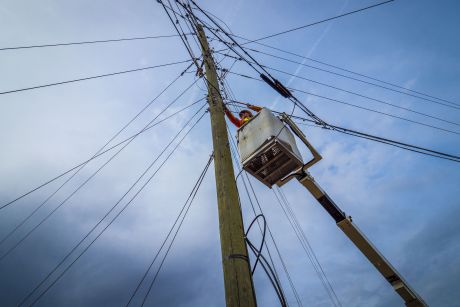This article was co-published with Salon.
Introduction
When the nation’s top telecommunications regulator decided to do away with the widely popular “network neutrality” rules that governed the Internet, his justification was that the regulations were slowing deployment.
But a new analysis by the Center for Public Integrity plus other factors cited by industry experts show that reasoning to be shallow at best and ridiculous at worst.
Most pointedly, while wireline deployment did slow while network neutrality rules were in place, it was due to at least one reason that had nothing to do with regulation: carriers were running out of potential customers, according to a Center analysis of Census and FCC data.
Between December 2012 and December 2014, the average population density of areas to which providers deployed wireline Internet access for the first time was 4,467 people per square mile.
Between December 2014 and December 2016 — by the time regulatory talk surfaced — the average population density of areas to which providers deployed wireline Internet access for the first time was a sparse 1,593 people per square mile.
One such community: the 550 square mile area that Anza Electric Cooperative covers for 5,000 co-op members.

Not in anybody’s business plan
On a recent evening, the 6,000-foot Thomas Mountain rises up behind Kevin Short, general manager of the utility cooperative, which provides power and fiber internet service to this rugged part of Riverside County, Calif. Until a couple of years ago, no commercial fixed-broadband providers would serve the community.
For many carriers, it’s a hassle to wire homes and buildings spread across unpaved roads and active fault lines.
Yet if you listen to the Trump administration, broadband installation in places like Anza slowed because of net neutrality rules — known as Title II regulation. Ajit Pai, chairman of the Federal Communications Commission, has bandied around statistics suggesting a connection between sluggish deployment and the 2015 rules to justify the elimination of network neutrality rules, which went into effect Monday.
The Center’s analysis doesn’t question there was a slowdown in deployment during the time the rules were in place. Nor does the FCC.
A February 2018 FCC Broadband Deployment Report states that from 2012 to 2014, the two years preceding regulation based on Title II of the 1934 Communications Act, fixed wireline broadband reached 29.9 million people who never had it before.
Between 2014 and 2016, only 13.5 million people saw an Internet service provider come to town for the first time.
But regulation had nothing to do with Anza’s lack of popularity.
“We just didn’t fit into any major carriers’ business plan,” says Short, a proponent of net neutrality. “I would have to suspect that customer service would be hard pressed to handle the many miles that it takes to get out here and get to see somebody’s home for a problem.”
In December 2015, Anza Electric Cooperative took the initiative and secured state funding to build fiber networks along existing electricity poles and wires.
Max capacity
Another aspect to consider regarding the slowdown in deployment is that household income in areas receiving wireline connectivity post-Title II was slightly lower than income in the more urban areas serviced earlier, between 2012 and 2014, according to the Center’s analysis.
Pai made no mention of the possibility that customer bases were reaching maximum capacity when he cast net neutrality as the bogeyman in May congressional testimony and during a March American Cable Association annual summit. The FCC decided in December 2017 to deregulate Internet service providers.
As of Monday, net neutrality rules no longer blocked Internet Service Providers (ISPs) from capping data, slowing connection speeds, or charging for faster delivery of content.
Under Title II rules, “money that could have expanded networks was now being siphoned off to pay lawyers and consultants to make sense of the new rules,” Pai remarked at the association summit.
Outgoing FCC Commissioner Mignon Clyburn, a Democrat, said the Center’s analysis and her own research refute allegations that Title II stalled ISP spending.
“I would agree there is no proof that the 2015 net neutrality rules caused any reduction in broadband investment,” Clyburn said in an emailed statement. The highest levels of broadband investment occurred during two decades in the late 1990s and early 2000s when the Title II regime was in place, she added.
Access increase?
Other data crunchers have shown that certain deployments of broadband, which the FCC defines as a download speed of at least 25 megabits per second, actually increased in the wake of net neutrality regulation.
At the end of 2014, about one-third of the U.S. population had access to two or more wireline ISPs and that percentage grew to more than half by the end of 2016, according to an analysis of the FCC’s annual block-level population estimates by media advocacy group Free Press. Faced with growing losses to cable competitors whose bandwidth met consumer demand for Netflix and other streaming video services, phone companies upped investments in higher-capacity broadband.
“The most frustrating thing to me about all of this is that no one really tries to say there’s got to be more than one causal factor,” said S. Derek Turner, research director for Free Press. There are multiple circumstances that cause spending to go up or down and that cause the rate of deployment to change, he added. “Sure, regulation could be one of those things, but there’s a lot of other things that probably are more realistic or logical to talk about,” Turner said.
Another potential influence on broadband deployments during the days of net neutrality was the ebb and flow of FCC Connect America Fund grants that support rural networks.
Ahead of the rules, between mid-2012 and the end of 2014, the FCC distributed nearly $5 billion in grants to rural ISPs for broadband deployment. When the net neutrality order took effect, the FCC was deliberating future Connect America funding and only disbursed $1.12 billion, nearly 50 percent less than the amount spent the year prior.
“This ramp up and subsequent sharp drop in rural broadband funding created a major, and far more likely impactful factor on rural broadband availability than any regulatory policy change,” Turner said.
The FCC substantiated its decision to revoke net neutrality using several outside reports that suggested carriers curtailed spending on upgrading and expanding their broadband networks when they feared regulations would erode financial returns.
Opposite conclusions
One March 2017 study by economist Hal Singer tracked a $3.6 billion, or a 5.6 percent, drop in wireline and wireless broadband capital expenditures from 2014, the year before the rules took effect, through 2016. Separately, a May 2017 report from Michael Horney, of the Free State Foundation, a free-market group, illustrated that in the two years following the Title II order, wireline and wireless broadband capital investment declined by $5.6 billion.
Neither Singer nor Horney disputed the Center’s analysis of sluggish broadband expansion. “I wouldn’t have made the argument the way that the FCC did” in its February 2018 conclusion about wireline deployment, said Singer, a principal at Economists Inc. and senior fellow at the George Washington Institute of Public Policy.
Instead, the FCC should have examined entrances of a second provider in communities, he added. Singer said he received no outside funding for his study, which was posted on his personal blog, but said that he has done a fair amount of work for USTelecom, an industry association funded by major telecommunications companies.
Singer even questions whether Title II triggered the dive in investments that he previously reported. “They went down around the time of Title II. Whether or not it was caused by Title II, it’s hard to say,” he said.
Horney, a research fellow at the Free State Foundation, voiced skepticism about the implications of the Center’s findings.
“I can’t disagree because I’m not sure what role reaching max capacity or net neutrality regulation played in slowing fixed broadband growth,” he said.
“Providers were unsure about what was going to be illegal and what was not and I think that slowed investment in general,” he said. There was “hesitancy to invest in new networks and upgrade old ones before they knew exactly what was on the table for the new laws.”

Investment increase?
Just last month Horney used data from the annual reports of thirteen large broadband providers to demonstrate that broadband capital investment increased 14 percent from the end of 2016 to the end of 2017, as broadband providers anticipated repeal of the order.
In an emailed statement, an FCC spokesman pointed to a number of steps the Trump administration has taken to help all Americans, not just those living in densely-populated areas, gain high-speed internet access. He referenced reforms to the Universal Service Fund, an FCC program that subsidizes telecommunications in underserved areas, and removal of “regulatory barriers.”
“One of those regulatory barriers was the prior FCC’s 2015 Title II Order, which had a disproportionate impact on smaller providers and those serving rural America,” the FCC spokesman stated. “Indeed, heavy-handed regulations are more likely to deter deployment in less densely-populated areas than densely-populated areas because the economic case for investing there is generally not as strong.”
To date, regulations have performed only a bit part in the staging of new telecommunications technologies and the net neutrality rule wasn’t one of them, said Blair Levin, a veteran FCC official who now consults Wall Street on telecom issues. “Competition builds the upgrades,” he said.
“Nobody on Wall Street actually looks at the net neutrality battle as having much to do with anything related to investment,” said Levin, who oversaw the Obama administration’s 2010 National Broadband Plan. The plan was required by an economic stimulus package that devoted $7.2 billion to build out infrastructure in underserved areas, for the most part.
Today, more than 30 percent of Americans in rural areas still lack access to high-speed wireline broadband versus 2 percent of urban dwellers, according to the February 2018 FCC deployment report.
“It’s hard to make money when you have a house per square mile,” said Craig Settles, a municipal broadband consultant.
Returns on investment in fiber networks typically require more than a couple of financial quarters and stockholders want quick returns, he said. “The incumbents don’t go where there are not enough people for them to get their money back,” he said, referring to traditional ISPs such as Verizon and AT&T. Verizon declined to comment and AT&T referred questions to USTelecom.
A USTelecom spokeswoman said in an emailed statement, “Title II further increases costs and raises new risks, making the business case for rural deployment even harder.”
John Horrigan, a researcher who studied Internet adoption while working on the 2010 National Broadband Plan, says the net neutrality issue is an important question, but it has had an unwanted side effect.
“A whole lot of other issues aren’t getting much attention,” he noted. Like, “how to close the digital divide, how to improve digital equity.”
Read more in Inequality, Opportunity and Poverty
Inequality, Opportunity and Poverty
Our top stories in business and politics this year
Broadband
Millions could lose low-cost phone service under FCC reforms
Government wants to cut Lifeline program citing waste, fraud and abuse


Join the conversation
Show Comments